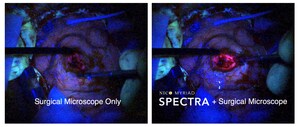Top Academic Healthcare Centers Presenting New Surgical Options for Stroke Patients
HOUSTON, Feb. 22, 2017 /PRNewswire/ -- New advanced technologies are increasing the effective surgical options to treat hemorrhagic stroke and other cerebrovascular diseases and evidence of improved patient outcomes are the result. The newest standardized surgical approach showing promising results will be featured at the International Stroke Conference (ISC) during two sessions today with presentations that include use of the BrainPath Approach™ by surgeons from Emory University School of Medicine/Grady Memorial Hospital and the Cleveland Clinic.
The success of hematoma evacuation using non-disruptive access with BrainPath® by NICO Corporation is also documented in a multi-center study recently published in Neurosurgery that shows greater than 90 percent clot evacuation and no new surgical deficits or deaths after early surgical intervention following hemorrhagic stroke (ICH). The 39-patient, two-year retrospective study The Safety and Feasibility of Image-Guided BrainPath-Mediated Transsulcul Hematoma Evacuation: A Multicenter Study, included 11 neurosurgical centers and 12 neurosurgeons and concluded "the [BrainPath] approach was safely performed in all patients with a relatively high rate of clot evacuation and functional independence".
"The results of this study offer a significant contribution to the evidence that there is a new and improved surgical option for appropriate patients who suffer from the devastating event of hemorrhagic stroke," said Gavin Britz, MD, chairman of the Department of Neurosurgery at Houston Methodist Hospital. "We are hopeful that the randomized controlled clinical trial will show these same results, and we may then be on our way to a new standard of care for ICH."
NICO patented BrainPath and Myriad® technologies are part of a new standardized trans-sulcal approach to brain surgery that navigates through the natural folds and fiber tracks of the brain and displaces brain tissue as it creates a dime-size corridor to the tumor or hemorrhage site. The technologies work together as a system using imaging and intervention to achieve non-disruptive access, automated tissue removal and clot evacuation, and intraoperative tissue collection and preservation. Growing clinical evidence published by multiple healthcare institutions is showing that using the standardized approach and technologies is a key factor in achieving repetitive surgical outcomes.
Today's BrainPath presentations at the ISC includes an Introduction to ENRICH: A Randomized Controlled Trial in ICH at 12:10 p.m. in the Industry Expert Theatre Booth #541 by Drs. Gustavo Pradilla, chief of neurosurgery at Grady Memorial Hospital, and Jonathan Ratcliff, assistant professor of emergency medicine and neurology (neurocritical care) at Emory University School of Medicine – both principle investigators in the trial. ENRICH is currently enrolling patients in the trial that will evaluate the clinical effectiveness of early surgical intervention using BrainPath following spontaneous ICH – the deadliest, costliest and most debilitating form of stroke. The trial will build on current peer-reviewed clinical data on the BrainPath Approach, including the multi-center study published in Neurosurgery.
"ENRICH shows the strong commitment of healthcare institutions from across the country to establishing a standardized minimally invasive approach to treating ICH and this high-risk patient population," Pradilla said. "I am hopeful the trial will produce the positive results these patients need for a new standard of better clinical outcomes."
Mark Bain, MD, neurosurgeon at Cleveland Clinic, will also present on surgical outcomes using BrainPath in a poster, Clinical Outcomes of Patients Undergoing BrainPath Assisted Evacuation of Intracerebral Hemorrhage, at 6:15 p.m. today in Hall E WP 352.
The ISC is the world's largest meeting on the science and treatment of cerebrovascular disease with more than 4,500 professionals attending. Hemorrhagic stroke is considered the deadliest class of stroke because blood that accumulates within the brain after the rupture is toxic, resulting in an early mortality rate of 32-50 percent. Studies show that early removal of the blood can potentially mitigate brain injury. However, the current standard of care calls for medical management of the patient or a "watch and see" protocol that often allows blood to remain in the brain.
BrainPath is cleared to provide subcortical access and visualization to diseases such as vascular abnormalities and malformations, primary and secondary brain tumors, and intraventricular tumors and cysts. The technology has been included in 34 peer-reviewed publications, posters and abstracts and more than 50 presentations at national and international neurosurgical conferences. More than 500 neurosurgeons, residents and fellows in the U.S. are trained on BrainPath and over 3,500 procedures have been completed. To learn more about BrainPath and other technologies used in the BrainPath systems approach, visit NICOneuro.com, follow news updates on LinkedIn, and view surgical videos on YouTube at NICOneuroCorp.
Contact: Sue Goin
[email protected]
M: 317.402.8690
SOURCE NICO Corporation
Related Links
WANT YOUR COMPANY'S NEWS FEATURED ON PRNEWSWIRE.COM?
Newsrooms &
Influencers
Digital Media
Outlets
Journalists
Opted In






Share this article